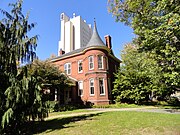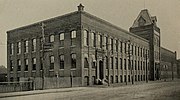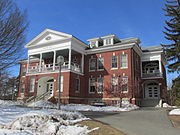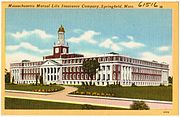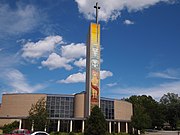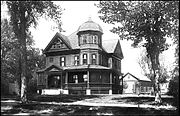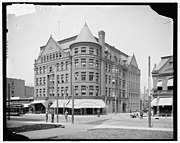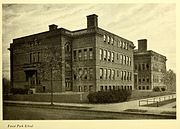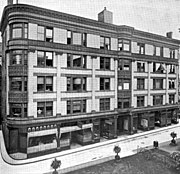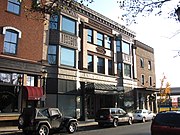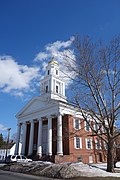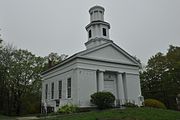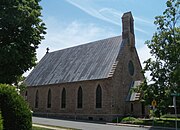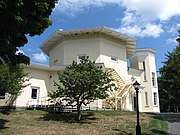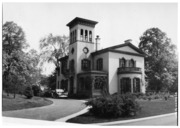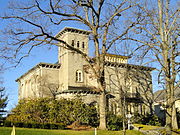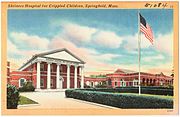User:JPRiley/Springfield
| This is not a Wikipedia article: It is an individual user's work-in-progress page, and may be incomplete and/or unreliable. For guidance on developing this draft, see Wikipedia:So you made a userspace draft. Find sources: Google (books · news · scholar · free images · WP refs) · FENS · JSTOR · TWL |
Springfield architects - various
BISSELL ALDERMAN[edit]
Bissell Alderman | |
|---|---|
| Born | September 19, 1912 |
| Died | April 30, 1999 (aged 86) |
| Nationality | United States |
| Occupation | Architect |



Bissell Alderman FAIA (1912–1999) was an American architect practicing in greater Springfield, Massachusetts from 1946 to 1978.
Life and career[edit]
Bissell Alderman was born September 19, 1912 to George P. B. Alderman and Hortense (Goslee) Alderman in Holyoke, Massachusetts. His father was a noted regional architect. He was educated in the Holyoke public schools and the Williston Academy. In 1930 he entered the Massachusetts Institute of Technology, graduating with a Bachelor of Arts in Architecture in 1935 and a Master of Architecture in 1937. During summers he worked in his father's office, G. P. B. Alderman & Company, where he worked on designs for Holyoke's main post office. After graduation he traveled in Europe for a year, returning to Boston in 1938. In 1938–39 he worked for Coolidge, Shepley, Bulfinch & Abbott and was an instructor at MIT. He participated in competitions to design proposed buildings for a school of fine arts and theatre at the College of William and Mary and the Smithsonian American Art Museum, and received an honorable mention in both. In 1939 he moved to Seattle, where he taught at the University of Washington before returning to MIT in 1941.
He remained at MIT until 1943, when he entered government service, working as a operations analyst until the end of World War II, for which he was awarded a Medal of Freedom. Beginning in 1945 he worked for Voorhees, Walker, Foley & Smith in New York City. In 1946 Alderman returned to Holyoke, where he formed the firm of Alderman & Alderman with his half-nephew, Albert D. Alderman Jr.[a] This was reorganized in 1951 to include engineer Archibald S. MacNeish, and was renamed Alderman & MacNeish. Soon afterward the office moved from downtown Holyoke to suburban West Springfield.
Alderman retired in 1978, followed by MacNeish in 1980. The firm continued as Alderman & MacNeish Inc. until dissolving in 2007. The firm's custom-designed office building at 594 Riverdale Street in West Springfield was demolished about five years later.
Personal life[edit]
In 1935 Alderman married Mary Evelyn Compton, daughter of Karl Taylor Compton, president of MIT from 1930 to 1948. They had three daughters. The Alderman family lived in South Hadley, where in 1947 Alderman built a Modernist home at 30 Red Ledge Road.
Alderman joined the American Institute of Architects in 1942, and was a vice president of the state-level chapter from 1951 to 1953. In 1970 he was elected to the AIA College of Fellows.
After retirement, the Aldermans retired to their second home in Jaffrey, New Hampshire. His wife died there in 1995, and he died April 30, 1999.[1]
https://www.courant.com/news/connecticut/hc-xpm-1999-05-04-9905040554-story.html
https://archive.org/details/storyofwesternma04wrig/page/n233/mode/2up?q=Alderman
Bowker directories
Architectural works[edit]
- Berkshire, Hampshire, Middlesex, Plymouth and Suffolk Houses,[b] University of Massachusetts Amherst, Amherst, Massachusetts (1948-49, partially extant)[2]
- Francis W. Sears house, 63 Pinehurst Rd, Belmont, Massachusetts (1949)[3]
- Memorial Hall, Williston Northampton School, Easthampton, Massachusetts (1951, altered)[2]
- Range testing building, United States Armory and Arsenal at Springfield, Springfield, Massachusetts (1953)[2]
- Agawam High School, 760 Cooper St, Agawam, Massachusetts (1955)[2]
- John M. Buchanan house, 56 Merriam St, Lexington, Massachusetts (1955-57)[4]
- Longmeadow High School, 95 Grassy Gutter Rd, Longmeadow, Massachusetts (1955, demolished 2013)[2]
- Mapleshade Elementary School, 175 Mapleshade Ave, East Longmeadow, Massachusetts (1955)[2]
- First Congregational Church Lancaster Education Building, 1 Church St, South Hadley, Massachusetts (1956, NRHP 2020)[5]
- Medford Public Library, 111 High St, Medford, Massachusetts (1958-59, demolished 2019)[6]
- Scott Hall, Williston Northampton School, Easthampton, Massachusetts (1958)[7]
- Western Massachusetts Electric Company headquarters, 174 Brush Hill Ave, West Springfield, Massachusetts (1959)[7]
- Algonquin Regional High School, 79 Bartlett St, Northborough, Massachusetts (1959)[7]
- Minnechaug Regional High School, 621 Main St, Wilbraham, Massachusetts (1959, demolished 2012)[7]
- Dormitory, Bay Path University, Longmeadow, Massachusetts (1960)[7]
- Junior high school, Longmeadow, Massachusetts (1960)[7]
- Mount Greylock Regional School, 1781 Cold Spring Rd, Williamstown, Massachusetts (1960–61)[8]
- Weston High School, 44 Wellesley St, Weston, Massachusetts (1961)[9]
- Tufts Library, 46 Broad St, Weymouth, Massachusetts (1965, demolished 2019)[10]
- Lenox Memorial High School, 197 East St, Lenox, Massachusetts (1965–66)[11]
- Mechanics Savings Bank Building, 200 Main St, Holyoke, Massachusetts (1965)[10]
- Mohawk Trail Regional High School, 26 Ashfield Rd, Buckland, Massachusetts (1967)[10]
- Amherst Regional Middle School, 170 Chestnut St, Amherst, Massachusetts (1969)[10]
- Lunt Silversmiths offices, Greenfield, Massachusetts (1969)[10]
- Wildwood Elementary School, 71 Strong St, Amherst, Massachusetts (1970)[12]
- Assabet Valley Regional Technical High School, 215 Fitchburg St, Marlborough, Massachusetts (1971–73)[13]
- Fort River Elementary School, 70 S East St, Amherst, Massachusetts (1971-72)[12]
- CSI Solar Center,[c] 11 Industrial Park Dr, Walpole, New Hampshire (1977–78)[14]
Notes[edit]
- ^ Albert Drake Alderman Jr. was born June 1, 1918 to Albert Drake Alderman Sr., the eldest son of George P. B. Alderman and his first wife. He trained as a draftsman in his grandfather's office and worked for several architects and contractors in Springfield. In April of 1946 he briefly established an independent architecture practice in Springfield, before forming the partnership with his uncle in August.
- ^ Plymouth and Suffolk Houses were demolished in the 1960s.
- ^ Built for Contemporary Systems Inc. and funded by the Energy Research and Development Administration as an experiment of passive solar building design.
References[edit]
- ^ "Alderman, Bissell" in Hartford Courant, May 4, 1999.
- ^ a b c d e f "Alderman, Bissell," American Architects Directory (New York: R. R. Bowker Company, 1956): 6.
- ^ "BLM.1000." mhc-macris.net. Massachusetts Historical Commission, n. d. Accessed August 10 2021.
- ^ "LEX.2145." mhc-macris.net. Massachusetts Historical Commission, n. d. Accessed August 10 2021.
- ^ "SOH.96." mhc-macris.net. Massachusetts Historical Commission, n. d. Accessed August 10 2021.
- ^ "MDF.1114." mhc-macris.net. Massachusetts Historical Commission, n. d. Accessed August 10 2021.
- ^ a b c d e f "Alderman, Bissell," American Architects Directory (New York: R. R. Bowker Company, 1962): 7.
- ^ "Regional School Committee Chooses Architect for Job" in North Adams Transcript, February 13, 1959, 11.
- ^ "New Weston High School Has About Everything" in Boston Globe, December 3, 1961, 38.
- ^ a b c d e "Alderman, Bissell," American Architects Directory (New York: R. R. Bowker Company, 1970): 10.
- ^ Berkshire Eagle, July 9, 1965, 11.
- ^ a b "AMH.1007." mhc-macris.net. Massachusetts Historical Commission, n. d. Accessed August 10 2021.
- ^ "Regional Vocational School Groundbreaking Ceremony Held" in Assabet Valley Beacon, April 15, 1971, 30.
- ^ "Jaffrey, N. H. Firm Receives Solar Heat Research Grant" in Sentinel and Enterprise, May 17, 1977, 16.
EMORY ALEXANDER ELLSWORTH (Holyoke)[edit]
Emory Alexander Ellsworth | |
|---|---|
| Born | August 3, 1852 |
| Died | December 8, 1915 (aged 63) |
| Nationality | United States |
| Occupation | Architect |
Emory A. Ellsworth (1852-1915) was an American architect and civil engineer practicing in Holyoke, Massachusetts from 1883 to 1915.
Life and career[edit]
Emory Alexander Ellsworth was born August 3, 1852 in Hardwick, Massachusetts to John Thayer Ellsworth and Hannah Maria (Lawrence) Ellsworth. He was educated in the public schools of Hardwick and Barre before enrolling in the Massachusetts Agricultural College at Amherst as a member of the Class of 1871, the first graduating class. After a year as a clerk for a Troy, New York provisions dealer, In 1872 he joined the office of Northampton civil engineer Emory C. Davis, who was then engaged on the new Holyoke Water Works. In 1873 he formed a partnership with Eugene E. Davis, nephew of his employer, as Davis & Ellsworth. This firm completed the construction of the water works, but was dissolved in 1876. For the next three years he was engaged in farming in Barre, and im 1879 returned to engineering as a civil engineer for the New Haven and Northampton Company. In 1880 he joined D. H. & A. B. Tower, then the leading architects and engineers of Holyoke. In 1883 he left the Tower brothers and extablished his own practice as an architect and civil engineer.[1][2][3]
Ellsworth was a sole practitioner until 1899, when he formed a partnership with engineer John J. Kirkpatrick, as Ellsworth & Kirkpatrick. When Kirkpatrick returned to city service in 1907, this was suceeded by Ellsworth & Howes, a partnership of Ellsworth and Lyman R. Howes. Ellsworth & Howes practiced together until Ellsworth's death in 1915.[2][3]
Ellsworth was elected City Engineer of Holyoke five times, in 1884, 1885, 1887, 1888 and 1889. His projects as City Engineer included the construction of the Whiting Street Reservoir.[3]
Personal life[edit]
Ellsworth was married twice. His first wife was Lucy Josephine Bradford of Florence, who he married in 1874.[1] They had two sons and one daughter. After her death in 1900, in 1902 he married second, to Carrie Meach of Holyoke. They had no children.[2]
The Ellsworth family lived in an apartment building at the corner of Essex and Walnut Street, which Ellsworth designed and owned.
Ellsworth died December 8, 1915 at home in Holyoke.[2]
Architectural works[edit]
- Whiting Street Building, Holyoke, Massachusetts (1885, demolished)[4]
- West Experiment Station, University of Massachusetts Amherst, Amherst, Massachusetts (1886-87)[5]
- The Essex, Holyoke, Massachusetts (1888)[4]
- Holyoke Envelope Company Mill, Holyoke, Massachusetts (1888-89, demolished)[4]
- East Experiment Station, University of Massachusetts Amherst, Amherst, Massachusetts (1889-90)[5]
- Taft Hall,[a] University of Rhode Island, Kingston, Rhode Island (1889)[6]
- Chemical Laboratory, New York State Agricultural Experiment Station, Geneva, New York (1891, demolished)[7]
- Phoenix Building, Springfield, Massachusetts (1894, demolished)[8]
- House for J. Wells Loomis, Westfield, Massachusetts (1895)[9][10]
- Migeon Avenue School (former), Torrington, Connecticut (1897)[11]
- Williamstown High School (former), Williamstown, Massachusetts (1897)[12]
- Cheshire Town Hall, Cheshire, Massachusetts (1898, NRHP 2017)[13]
- Munson Hall, University of Massachusetts Amherst, Amherst, Massachusetts (1899)[5]
- South Infirmary, Northampton State Hospital, Northampton, Massachusetts (1901-03, NRHP 1994, demolished 2006)[14]
- South Street School, Ware, Massachusetts (1901, demolished 2018)[15]
- Draper Hall, University of Massachusetts Amherst, Amherst, Massachusetts (1903-05)[5]
- North Infirmary, Northampton State Hospital, Northampton, Massachusetts (1903-05, NRHP 1994, demolished 2006)[16]
- Welker Apartments, South Hadley Falls, Massachusetts (1910)[17]
- Richmond Apartments, South Hadley Falls, Massachusetts (1910)[18]
- House for John K. Judd, Holyoke, Massachusetts (1912)[19]
- Griffin Apartments, South Hadley Falls, Massachusetts (1913)[20]
- Holyoke Sanitorium, Holyoke, Massachusetts (1911-12, demolished)
Gallery of architectural works[edit]
-
Whiting Street Building, Holyoke, Massachusetts, 1885.
-
West Experiment Station, University of Massachusetts Amherst, Amherst, Massachusetts, 1886-87.
-
Holyoke Envelope Company Mill, Holyoke, Massachusetts, 1888-89.
-
East Experiment Station, University of Massachusetts Amherst, Amherst, Massachusetts, 1889-90.
-
Taft Hall, University of Rhode Island, Kingston, Rhode Island, 1889.
-
Phoenix Building, Springfield, Massachusetts, 1894.
-
Cheshire Town Hall, Cheshire, Massachusetts, 1898.
-
Draper Hall, University of Massachusetts Amherst, Amherst, Massachusetts, 1903-05.
Notes[edit]
- ^ A contributing property to the University of Rhode Island Historic District, listed on the National Register of Historic Places in 2017.
References[edit]
- ^ a b General Catalogue of the Massachusetts Agricultural College (Amherst: Massachusetts Agricultural College, 1886): 22-23.
- ^ a b c d J. Wallace Tower, "Memoir of Emory Alexander Ellsworth," Transactions of the American Society of Civil Engineers 80 (1916): 2136-2137.
- ^ a b c James L. Tighe and Albert H. Lavalle, "Emory Alexander Ellsworth," Journal of the Boston Society of Civil Engineers 3, no. 9 (November 1916): 480-481.
- ^ a b c "Emory A. Ellsworth" in Inland Massachusetts Illustrated (Springfield: Elstner Publishing Company, 1890): 136.
- ^ a b c d Paul F. Norton, Amherst: A Guide to its Architecture (Amherst: Amherst Historical Society, 1975)
- ^ University of Rhode Island Historic District NRHP Registration Form (2017)
- ^ Tenth Annual Report of the Board of Control of the New York Agricultural Experiment Station for the Year 1891 (Albany: State of New York, 1892)
- ^ "Illustrations," American Architect and Building News 51, no. 1049 (February 1 1896): 55.
- ^ "Illustrations," American Architect and Building News 47, no. 1001 (March 2 1895): 95.
- ^ "WSF.265." mhc-macris.net. Massachusetts Historical Commission, n. d. Accessed September 15 2021.
- ^ "Illustrations," Architecture and Building 26, no. 3 (January 16 1897): 31.
- ^ "Building Intelligence," American Architect and Building News 56, no. 1119 (June 5 1897): xv.
- ^ "CHS.74." mhc-macris.net. Massachusetts Historical Commission, n. d. Accessed September 15 2021.
- ^ "NTH.1154." mhc-macris.net. Massachusetts Historical Commission, n. d. Accessed September 15 2021.
- ^ "WAR.94." mhc-macris.net. Massachusetts Historical Commission, n. d. Accessed September 15 2021.
- ^ "NTH.1155." mhc-macris.net. Massachusetts Historical Commission, n. d. Accessed September 15 2021.
- ^ "SOH.161." mhc-macris.net. Massachusetts Historical Commission, n. d. Accessed September 15 2021.
- ^ "SOH.189." mhc-macris.net. Massachusetts Historical Commission, n. d. Accessed September 15 2021.
- ^ "HLY.590." mhc-macris.net. Massachusetts Historical Commission, n. d. Accessed September 15 2021.
- ^ "SOH.160." mhc-macris.net. Massachusetts Historical Commission, n. d. Accessed September 15 2021.
GUY KIRKHAM[edit]
Guy Kirkham | |
|---|---|
| Born | December 14, 1864 |
| Died | March 6, 1935 (aged 70) |
| Nationality | United States |
| Occupation | Architect |



Guy Kirkham (1864-1935) was an American architect based in Springfield, Massachusetts.
Life and career[edit]
Guy Kirkham was born November 13, 1864 in Springfield, Massachusetts to William Kirkham Jr. and Harriet Newell (Merriam) Kirkham. His maternal grandfather was Charles Merriam, a founder of what is today Merriam-Webster in 1831. Kirkham was educated in the Springfield public schools and St. Paul's School before entering the Massachusetts Institute of Technology, graduating with the class of 1887. He then worked for Cass Gilbert in St. Paul until 1889 and for Renwick, Aspinwall & Russell in New York City until returning to Springfield in 1891. He briefly worked for Gardner, Pyne & Gardner but then embarked on a grand tour of Europe, traveling in England, France and Italy. When Kirkham returned to the United States in 1893, he established himself as an architect in Springfield. He was a sole practitioner until 1904, when he formed a partnership with Edwin J. Parlett.[a] They practiced together as Kirkham & Parlett until Parlett's death in 1931. Kirkham then resumed private practice until his own death in 1935.[1]
In 1897 Kirkham joined the American Institute of Architects as a fellow. He was a member of several social and fraternal organizations in Springfield, and was involved in several local philanthropic causes.[1]
Personal life[edit]
Kirkham married in 1892, to Grace Freeman Dwight of Springfield. They had one son and three daughters.[1]
The Kirkham family lived in a house at 120 Clarendon Street in Springfield, built in 1909 in an English style.[2] He was a parishoner of the Church of the Unity, the building of which had the distinction of being the first completed work of architect H. H. Richardson.[1]
Kirkham died August 3, 1935 in Springfield.[1]
Legacy[edit]
Architectural works[edit]
- Morgan Block, Springfield, Massachusetts (1929, NRHP 1983)
Gallery of Architectural works[edit]
Notes[edit]
- ^ Parlett came to Springfield in 1893 as representative of Bruce Price to superintend the construction of the house of Daniel B. Wesson. After completion of the house Parlett practiced independently in Springfield until forming his partnership with Kirkham.
References[edit]
THURSTON MUNSON[edit]
Thurston Munson (1906-1998) was an American artist and architect practicing in Springfield, Massachusetts.
Life and career[edit]
Thurston Wells Munson was born April 24, 1906 in Greenfield, Massachusetts to Frank Manuel Munson and Dollie Jane (Wells) Munson. He attended the local schools before attending what is now the University of the Arts in Philadelphia. A prize for his work enabled his to travel in Europe, Africa and Asia, continuing to pay his way by painting portraits, including one for . He eventually returned to Paris, where he opened a studio, but returned to the United States in 1929 for a commission. He soon began painting large murals for hotels, restaurants and nightclubs, and in 1935 opened an office for the practice of interior design. This led to larger architectural work. He returned to Massachusetts in 1940, settling in Springfield. He began formally practicing architecture in 1952, when he formed a partnership with engineer A. George Mallis as Munson & Mallis. In the late 1950s they were associated with Alfred E. Reinhardt in the firm of Munson, Mallis & Reinhardt, but otherwise remained associated as Munson & Mallis until 1970. Throughout much of this period they simultaneously operated the firm of Munson, Mallis, Bradley, Patterson & Burgener, engineers, which gradually developed into Mallis's own practice. After separating Munson formed the new firm of Thurston Munson and Associates Inc., which operated until its dissolution in 1983, when Munson retired from architecture.
Trained in fine arts, Munson often provided murals and mosaics for the buildings designed by his firm. Exterior mosaics survive at two of his churches, at Holy Cross R. C. Church in South Portland(1957-58), which depicts the life of Christ, and at Bethesda Lutheran Church in Springfield (1959-60), which depicts Martin Luther. A set of murals which survives was created in 1947 for Adajian's, a Hartford restaurant. He created a series of fourteen murals depicting scenes from One Thousand and One Nights of which thirteen survive. When the restaurant closed in 1986 they were acquired and restored by Munson. They have been in storage since his death.[1]
Personal life[edit]
Marriage
After retiring, Munson returned to his hometown where he continued painting.
A president of the Society of American Registered Architects.
Murals and mosaics.
Architectural works[edit]
- House for Thurston Munson, Springfield, Massachusetts (1954)[3]
- American Pad and Paper Company Plant, Holyoke, Massachusetts (1957)[4]
- Holy Cross R. C. Church, South Portland, Maine (1957-58)[5]
- Parish building of Bethesda Lutheran Church, Springfield, Massachusetts (1959-60)[6]
- School of St. Mary R. C. Church, Ware, Massachusetts (1959)[7]
- Addition to the East Street School, Ludlow, Massachusetts (1960)[8]
- Lakeside Hall, Springfield College, Springfield, Massachusetts (1960-61)[9]
- Schoo-Bemis Science Center, Springfield College, Springfield, Massachusetts (1960-61)[10]
- Easthampton High School (former), Easthampton, Massachusetts (1961, demolished 2019)[11]
- Naismith Memorial Basketball Hall of Fame,[a] Springfield, Massachusetts (1961-68, altered 1987-89)[12]
- Ludlow High School, Ludlow, Massachusetts (1962)[13]
- Addition to the Clifford M. Granger School, Agawam, Massachusetts (1963-64)[14]
- Security National Bank Building, Springfield, Massachusetts (1963)[15]
- Springfield Gas Light Company Plant, Springfield, Massachusetts (1964, demolished 2015)[16]
- Colonial Haven Apartments, Agawam, Massachusetts (1965-66)[17]
- Art Linkletter Natatorium, Springfield College, Springfield, Massachusetts (1966-67)[18]
- United States Post Office, Springfield, Massachusetts (1967)[19]
- Learning Resource Center, Worcester State University, Worcester, Massachusetts (1968-71)
- Meadowbrook Manor, Agawam, Massachusetts (1976-77)[20]
Gallery of architectural works[edit]
-
Holy Cross R. C. Church, South Portland, Maine, 1957-58.
-
Learning Resource Center, Worcester State University, Worcester, Massachusetts, 1968-71.
Notes[edit]
- ^ Now the Health Sciences Center of Springfield College.
References[edit]
- ^ Jane D. Lee, "Adajian's Restaurant: After 20 Years In Storage, Murals Still Captivate," courant.com. Hartford Courant, July 27 2018. Accessed August 10 2021.
- ^ https://www.newspapers.com/newspage/441921737/
- ^ "SPR.3539." mhc-macris.net. Massachusetts Historical Commission, n. d. Accessed August 10 2021.
- ^ "American Pad & Paper Pushes Construction of New Plant," Office Appliances 105, no. 3 (March 1957): 112.
- ^ "Pie Shaped Catholic Church Dedicated in Portland Today," Boston Globe, July 13 1958, 33.
- ^ https://www.bethesdaspringfield.org/bethesda
- ^ "Construction Reports," Engineering News-Record 163, no. 1 (July 2 1959): 68.
- ^ "LUD.182." mhc-macris.net. Massachusetts Historical Commission, n. d. Accessed August 10 2021.
- ^ https://cdm16122.contentdm.oclc.org/digital/collection/p15370coll2/id/2030
- ^ https://springfieldcollege.contentdm.oclc.org/digital/collection/p15370coll2/id/5100/rec/26
- ^ "Construction Reports," Engineering News-Record 166, no. 12 (March 23 1961): 196.
- ^ https://springfieldcollege.contentdm.oclc.org/digital/collection/p15370coll2/id/21177/rec/8
- ^ "Electric Heating Practical for New England Homes," Boston Globe, January 7 1962, AB17.
- ^ "AGA.E." mhc-macris.net. Massachusetts Historical Commission, n. d. Accessed August 10 2021.
- ^ Contractor News 3, no. 4 (April 1964): 32.
- ^ New Buildings With Fallout Protection (Arlington: Department of Defense, 1965)
- ^ "Elderly Housing Ground Breaking Ceremonies Is Set For June," Agawam Independent, May 6 1965, 1 and 5.
- ^ https://springfieldcollege.contentdm.oclc.org/digital/collection/p15370coll2/id/3036/rec/9
- ^ "Construction Reports," Engineering News-Record 178, no. 18 (May 4 1967): 110.
- ^ Agawam Town Report, 1984 (Agawam: Town of Agawam, 1985)
O. E. NAULT[edit]
architect of Worcester, Massachusetts.
Life and career[edit]
Onesime E. Nault was born April 29, 1864 in Wotton, Quebec. He attended the Wotton schools and the academy at Coaticook, followed by a year at the Séminaire de Sherbrooke. He worked for architect David Ouellet in Quebec City for several years before establishing his own practice in Nicolet. He immigrated to the United States in 1887, settling in Worcester. He worked as an architect for the Norcross Brothers before reestablishing his practice in Worcester in 1898.
Personal life[edit]
Norman Dollard Nault was born October 11, 1901. He attended Assumption College and Harvard University, graduating from the latter in 1928 with a Master of Architecture degree.
Albert George Nault was born May 8, 1904. He also attended Assumption College, before attending the Massachusetts Institute of Technology, from which he graduated in 1930 with a Bachelor of Science in Architecture degree.
Legacy[edit]
Architectural works[edit]
Churches[edit]
- Our Lady of the Holy Rosary, Gardner, Massachusetts (completed 1915)[1]
- Holy Name of Jesus, Worcester, Massachusetts (completed 1916)
- St. Joseph, Worcester, Massachusetts (1926)[2]
- St. Francis of Assisi, Fitchburg, Massachusetts (1926-28)[3]
- Immaculate Conception, Fitchburg, Massachusetts (completed 1929)[4]
Parish buildings[edit]
- Parochial school, Sacred Heart of Jesus, Webster, Massachusetts (1913)[5]
- Parochial school, St. Joseph, Worcester, Massachusetts (1914)[2]
- Parochial school, Immaculate Conception, Holyoke, Massachusetts (1916-17)[6]
- Parochial school, Nativity of the Blessed Virgin Mary, Chicopee, Massachusetts (1921)[7]
- Convent, Immaculate Conception, Holyoke, Massachusetts (1924-25)[8]
- Parochial school, Our Lady of the Holy Rosary, Gardner, Massachusetts (1924)[1]
- Parochial school, St. John the Baptist, Ludlow, Massachusetts (1926)[9]
- Rectory, St. Joseph, Worcester, Massachusetts (1926)[2]
- Parochial school, Notre Dame du Bon Conseil, Easthampton, Massachusetts (1932)[10]
- Parochial school, Our Lady of Notre Dame, Pittsfield, Massachusetts (1937)[11]
- Parochial school, Our Lady of the Assumption, Millbury, Massachusetts (1925)[12]
Institutions[edit]
- Assumption College buildings, Worcester, Massachusetts (no date)[1]
- St. Francis Home, Worcester, Massachusetts (no date)[1]
Secular[edit]
- Naquag Elementary School, Rutland, Massachusetts (1965)[13]
- George C. Gordon Library, Worcester Polytechnic Institute, Worcester, Massachusetts (1966-67)[14]
- Westborough Public Library addition, Westborough, Massachusetts (1980)[15]
Gallery of architectural works[edit]
-
Holy Name of Jesus R. C. Church, Worcester, Massachusetts
-
George C. Gordon Library, Worcester Polytechnic Institute, Worcester, Massachusetts, 1966-67.
Notes[edit]
References[edit]
- ^ a b c d A Century of Catholicism in Western Massachusetts, ed. Michael S. Shea (Springfield: Mirror Press, 1931)
- ^ a b c "WOR.DT." mhc-macris.net. Massachusetts Historical Commission, n. d. Accessed September 3 2021.
- ^ "FIT.2045." mhc-macris.net. Massachusetts Historical Commission, n. d. Accessed September 3 2021.
- ^ "FIT.2048." mhc-macris.net. Massachusetts Historical Commission, n. d. Accessed September 3 2021.
- ^ "WEB.269." mhc-macris.net. Massachusetts Historical Commission, n. d. Accessed September 3 2021.
- ^ "HLY.4." mhc-macris.net. Massachusetts Historical Commission, n. d. Accessed September 3 2021.
- ^ "CHI.371." mhc-macris.net. Massachusetts Historical Commission, n. d. Accessed September 3 2021.
- ^ "HLY.1416." mhc-macris.net. Massachusetts Historical Commission, n. d. Accessed September 3 2021.
- ^ "LUD.118." mhc-macris.net. Massachusetts Historical Commission, n. d. Accessed September 3 2021.
- ^ Engineering News-Record 108, no. 26 (March 30 1932): 44.
- ^ "PIT.663." mhc-macris.net. Massachusetts Historical Commission, n. d. Accessed September 3 2021.
- ^ Engineering News-Record 108, no. 26 (January 8 1925): 44.
- ^ "RUT.10." mhc-macris.net. Massachusetts Historical Commission, n. d. Accessed September 3 2021.
- ^ "WOR.2268." mhc-macris.net. Massachusetts Historical Commission, n. d. Accessed September 3 2021.
- ^ "WBO.204." mhc-macris.net. Massachusetts Historical Commission, n. d. Accessed September 3 2021.
BENJAMIN HAMMETT SEABURY[edit]
Benjamin Hammett Seabury | |
|---|---|
| Born | April 8, 1856 |
| Died | April 21, 1945 (aged 89) |
| Nationality | United States |
| Occupation | Architect |
B. Hammett Seabury (1856-1945) was an American architect practicing in Springfield, Massachusetts.
Life and career[edit]
Benjamin Hammett Seabury was born April 8, 1856 in Newport, Rhode Island to Thomas Mumford Seabury and Caroline A. (Lovie) Seabury.[1] He attended the public schools, after which he worked for Newport architect James Fludder.[2] In 1877 he entered the architectural school of the Massachusetts Institute of Technology, graduating in 1879.[3] He then moved to Springfield, joining the office of Eugene C. Gardner. In 1882 he formed a partnership with Francis R. Richmond, a senior architect with Gardner's firm, practicing as Richmond & Seabury. They worked together until 1890, when the partnership was dissolved and each opened an independent office.[4] On January 1, 1920 the office was reorganized as the B. Hammett Seabury Company with the addition of his son, Harry Mumford Seabury, and J. Lewis Kelley.[5] Seabury continued to practice architecture until at least the late 1930s.
Personal life[edit]
Seabury married in 1883 to Anna Caroline Kelley of Warren, Rhode Island.[6] They had two sons.[1] The Seabury family home was at 188 Florida Street in the McKnight neighborhood, which Seabury had built in 1888.[7]
In 1893 Seabury became a member of the Architectural League of New York.[2]
Seabury died April 21, 1945.[8]
Architectural works[edit]
- Y. M. C. A. Building, Southbridge, Massachusetts (1891-92, demolished 1975)[9]
- House for Don H. Woodward, Keene, New Hampshire (1892)[10]
- House for Samuel W. Comstock, Greenfield, Massachusetts (1893)[11][12]
- Judd Gymnasia, Springfield College, Springfield, Massachusetts (1894)[13]
- Y. M. C. A. Building, Springfield, Massachusetts (1894, demolished)[14]
- Mill Street Fire Station (former), Springfield, Massachusetts (1894-95)[15]
- Oakland Street Fire Station (former), Springfield, Massachusetts (1894-95)[16]
- Administration Building, Springfield College, Springfield, Massachusetts (1895-96, altered)[13]
- House for Charles M. Woodward, West Springfield, Massachusetts (1895)[17][18]
- Forest Park School, Springfield, Massachusetts (1896-98 et seq., altered)[19]
- Hammond Block, Northampton, Massachusetts (1896)[20]
- Besse Building,[a] Springfield, Massachusetts (1897-98, demolished)[21]
- Brightwood School, Springfield, Massachusetts (1898-99 et seq.)[22]
- Valley View Memorial Chapel, Ticonderoga, New York (1900-01)[23]
- Fuller Building, Amesbury, Massachusetts (1901)[24]
- Armory Street Fire Station, Springfield, Massachusetts (1902, demolished)[25]
- Kensington Avenue School, Springfield, Massachusetts (1908)[26]
- Patton Building, Springfield, Massachusetts (1909, NRHP 1983)[27]
- Central Fire Station, Springfield, Massachusetts (1910-11, demolished)[28]
- Margaret Street Fire Station (former), Springfield, Massachusetts (1910-11)[29]
- St. John's Congregational Church (former), Springfield, Massachusetts (1911, NRHP 2016)[30]
- Van der Hayden Apartments, Springfield, Massachusetts (1914)[31]
- Third National Bank Building,[b] Springfield, Massachusetts (1915)[32]
- Rogers High School annex, Newport, Rhode Island (1921-22, demolished)[33]
- Thomas H. Clarke School, Jamestown, Rhode Island (1922, demolished)
- Chatham Court Apartments, Springfield, Massachusetts (1923)[34]
- Shean Block, Springfield, Massachusetts (1927)[35]
- Massreco Street Fire Station, Springfield, Massachusetts (1930)[36]
- Hope Congregational Church (former),[c] Springfield, Massachusetts (1937-38)[37][38]
- Bethel A. M. E. Church,[d] Springfield, Massachusetts (1939)[39]
Gallery of architectural works[edit]
-
House for Don H. Woodward, Keene, New Hampshire, 1892.
-
Y. M. C. A. Building, Springfield, Massachusetts, 1894.
-
Administration Building, Springfield College, Springfield, Massachusetts, 1895-96.
-
Forest Park School, Springfield, Massachusetts, 1896-98 et seq.
-
Besse Building, Springfield, Massachusetts, 1897-98.
-
Brightwood School, Springfield, Massachusetts, 1898 et seq.
Notes[edit]
- ^ Seabury moved his offices into this building in 1898 and remained there for the rest of his career.
- ^ In association with Starrett & van Vleck of New York City. Now known as Harrison Place.
- ^ This church replaced the original Hope Congregational Church, designed by Richmond & Seabury in 1882, which burned in 1931. The second church is now home to the Shiloh Seventh-day Adventist Church.
- ^ Incorporated into the new church was the former building of the Springfield Day Nursery, built in 1917 to a design by Kirkham & Parlett.
References[edit]
- ^ a b "Seabury" in Representative Men and and Old Families of Rhode Island, vol. 1 (Chicago: J. H. Beers & Company, 1908): 165-168.
- ^ a b "Directory of Architects" in American Art Annual, 1905-1906, vol. 5, ed. Florence N. Levy (New York: American Art Annual, 1905): 500.
- ^ Massachusetts Institute of Technology, Cambridge, Register of Former Students (Cambridge: Massachusetts Institute of Technology, 1920)
- ^ "Personal," Engineering and Building Record 21, no. 25 (May 24 1890): 386.
- ^ "Announcements," Architectural Forum 32, no. 2 (February 1920): 48.
- ^ William F. Reed, The Descendants of Thomas Durfee of Portsmouth, R. I., vol. 1 (Washington: William F. Reed, 1903): 287-288.
- ^ "SPR.1046." mhc-macris.net. Massachusetts Historical Commission, n. d. Accessed August 19 2021.
- ^ "Deaths," Technology Review 48, no. 1 (November 1945): v.
- ^ "Building Record," Educator 1, no. 10 (November 1891): 13.
- ^ New Hampshire Homes (Concord: James A. Wood, 1895)
- ^ "Massachusetts," Architecture and Building 29, no. 5 (July 29 1893): xvii.
- ^ "GRE.45." mhc-macris.net. Massachusetts Historical Commission, n. d. Accessed August 30 2021.
- ^ a b International YMCA Training School Trustee Minutes and Reports, 1890 to 1898, page 27 and others.
- ^ "Building Intelligence," Engineering Record 29, no. 17 (March 24 1894): 277.
- ^ "SPR.184." mhc-macris.net. Massachusetts Historical Commission, n. d. Accessed August 30 2021.
- ^ "SPR.3857." mhc-macris.net. Massachusetts Historical Commission, n. d. Accessed August 30 2021.
- ^ "Building Intelligence," American Architect and Building News 47, no. 1004 (March 23 1895): xvii.
- ^ "WSG.133." mhc-macris.net. Massachusetts Historical Commission, n. d. Accessed August 30 2021.
- ^ "SPR.3856." mhc-macris.net. Massachusetts Historical Commission, n. d. Accessed August 30 2021.
- ^ "NTH.2058." mhc-macris.net. Massachusetts Historical Commission, n. d. Accessed August 30 2021.
- ^ "Building Intelligence," American Architect and Building News 56, no. 1118 (May 29 1897): xiv.
- ^ "SPR.2561." mhc-macris.net. Massachusetts Historical Commission, n. d. Accessed August 30 2021.
- ^ "Public Buildings," Engineering Record 42, no. 23 (December 8 1900): 557.
- ^ "Business Buildings," Engineering Record 44, no. 14 (October 5 1901): 334.
- ^ "SPR.4179." mhc-macris.net. Massachusetts Historical Commission, n. d. Accessed August 30 2021.
- ^ "SPR.3852." mhc-macris.net. Massachusetts Historical Commission, n. d. Accessed August 30 2021.
- ^ "SPR.4." mhc-macris.net. Massachusetts Historical Commission, n. d. Accessed August 30 2021.
- ^ "Buildings," Engineering News 63, no. 19 (May 12 1910): 195.
- ^ "Buildings," Engineering News 63, no. 2 (January 13 1910): 15.
- ^ "SPR.CL." mhc-macris.net. Massachusetts Historical Commission, n. d. Accessed August 30 2021.
- ^ "SPR.4404." mhc-macris.net. Massachusetts Historical Commission, n. d. Accessed August 30 2021.
- ^ "New York, N. Y.," American Contractor 36, no. 23 (June 5 1915): 63.
- ^ "New Construction," Power 53, no. 7 (February 15 1921): 291.
- ^ Heating and Ventilating Magazine 21, no. 12 (December 1924): 130.
- ^ "SPR.116." mhc-macris.net. Massachusetts Historical Commission, n. d. Accessed August 30 2021.
- ^ "SPR.3434." mhc-macris.net. Massachusetts Historical Commission, n. d. Accessed August 30 2021.
- ^ "Churches," Engineering News-Record 106, no. 12 (March 19 1931): 59.
- ^ Photo Record
- ^ "SPR.4175." mhc-macris.net. Massachusetts Historical Commission, n. d. Accessed August 30 2021.
HENRY ALEXANDER SYKES[edit]
Henry Alexander Sykes | |
|---|---|
| Born | January 31, 1810 |
| Died | December 13, 1860 (aged 50) |
| Nationality | United States |
| Occupation | Architect |
Henry A. Sykes (1810-1860) was an American master builder and architect who lived and worked in Suffield, Connecticut and Springfield, Massachusetts.
Life and career[edit]
Henry Alexander Sikes, later Sykes, was born January 31, 1810 in Suffield, Connecticut to Alexander Sikes and Lois (Bliss) Sikes. He was orphaned at a young age and was raised by his grandfather, Victory Sikes Jr. He was educated in the Suffield public schools before being apprenticed to the Springfield master builder Chauncey Shepard. He is also believed to have been educated in architecture by the New Haven architect Ithiel Town. Sykes was working on his own by 1835, when he designed and built a meeting house for the First Church of Christ, Congregational of Suffield. By 1841 he opened an architect's office in Springfield, though he continued to live in Suffield. He worked as an architect and builder throughout the Connecticut River Valley until his death in 1860, though declining health caused him to reduce his activity in the 1850s.[1]
Personal life[edit]
Sykes married in 1836, to Julia Ann Fowler of Suffield. They had six children.[1]
Sykes was active in the Congregational church, and became a deacon of the church in Suffield in 1857.[1]
Architectural works[edit]
- First Church of Christ, Congregational, Suffield, Connecticut (1835, demolished)[1]
- New Marlborough Meeting House, New Marlborough, Massachusetts (1837-39)[1]
- Second Baptist Church, Suffield, Connecticut (1839)[1]
- First Congregational Church, Chester, Massachusetts (1840)[2]
- Union House,[a] Springfield, Massachusetts (1846, demolished 2019)
- Episcopal Church of St. James and St. Andrew, Greenfield, Massachusetts (1847)[3]
- Woods Cabinet and Lawrence Observatory, Amherst College, Amherst, Massachusetts (1847-48)[4]
- House for John Mills, Springfield, Massachusetts (1849-50, NRHP 1973)[5]
- Extension of the Hampden County Courthouse, Springfield, Massachusetts (1851-52, demolished)[1]
- Morgan Hall, Amherst College, Amherst, Massachusetts (1852-53)[4]
- House for Francis Tiffany,[b] Springfield, Massachusetts (1853, demolished 1980)[1]
- Appleton Hall, Amherst College, Amherst, Massachusetts (1855, altered)[4]
- House for Julius Fowler, Suffield, Connecticut (1858-59)[1]
- Monument to Benjamin Ruggles, Old Center Cemetery, Suffield, Connecticut (1858)[1]
Gallery of architectural works[edit]
-
New Marlborough Meeting House, New Marlborough, Massachusetts, 1837-39.
-
Second Baptist Church, Suffield, Connecticut, 1839.
-
First Congregational Church, Chester, Massachusetts, 1840.
-
Episcopal Church of St. James and St. Andrew, Greenfield, Massachusetts, 1847-48.
-
House for John Mills, Springfield, Massachusetts, 1849-51.
-
Morgan Hall, Amherst College, Amherst, Massachusetts, 1852-53.
-
Appleton Hall, Amherst College, Amherst, Massachusetts, 1855.
Notes[edit]
- ^ The Main Street facade has been preserved as part of the new MGM Springfield.
- ^ Later owned by Samuel Bowles.
References[edit]
- ^ a b c d e f g h i j David Hosford, "Henry A. Sykes, Western New England Architect," Nineteenth Century Magazine 32, no. 2 (Fall 2012)
- ^ "CHT.1." mhc-macris.net. Massachusetts Historical Commission, n. d. Accessed August 6 2021.
- ^ "GRE.77." mhc-macris.net. Massachusetts Historical Commission, n. d. Accessed August 6 2021.
- ^ a b c Bryant F. Tolles Jr., Architecture & Academe: College Buildings in New England Before 1860 (Lebanon: University Press of New England, 2011)
- ^ "SPR.250." mhc-macris.net. Massachusetts Historical Commission, n. d. Accessed August 6 2021.
GEORGE WOOD TAYLOR[edit]
George Wood Taylor | |
|---|---|
| Born | July 14, 1868 |
| Died | July 15, 1921 (aged 53) |
| Nationality | United States |
| Occupation | Architect |
G. Wood Taylor (1868-1921) was an American architect based in Springfield, Massachusetts.
Life and career[edit]
George Wood Taylor was born July 14, 1868 in Morristown, New Jersey to Henry Taylor and Louisa (Wood) Taylor. He was educated at the Trinity School in Tivoli, New York before attending the Massachusetts Institute of Technology, graduating in 1890. He worked for William Ralph Emerson and Shepley, Rutan & Coolidge in Boston before moving to Springfield in 1895, where he established his own practice. He specialized in the design of houses, and was responsible for many large suburban homes in Springfield as well as cottages on the Massachusetts coast, especially in Hyannis Port. He practiced until 1913, when declining health caused him to retire.[1]
Personal life[edit]
Taylor married in 1895 to Lillian James McKnight of Springfield. Her father, William H. McKnight, was a developer of Springfield's suburban neighborhoods and would become an important client. They had one child, a daughter.[1]
Taylor's home, which he designed in 1910, is located at 41 Ridgewood Place in Springfield.[1]
Taylor died July 15, 1921 at his summer home in Hyannis Port, Massachusetts. He had built this house, "Stonehurst," about 1912, and it was destroyed by fire shortly after his death. His widow had it rebuilt to the original design, and it still stands at 11 Maywood Avenue.[1]
Architectural works[edit]
- House for Col. Stanhope E. Blunt, 83 Ridgewood Ter, Springfield, Massachusetts (1911)[2]
Notes[edit]
References[edit]
MAX HAROLD WESTHOFF[edit]
Max Harold Westhoff | |
|---|---|
| Born | October 13, 1874 |
| Died | 1951 |
| Nationality | United States |
| Occupation | Architect |
Max H. Westhoff (1874-1951) was an American architect practicing in Saranac Lake, New York and Springfield, Massachusetts.
Life and career[edit]
Max Harold Westhoff was born October 13, 1874 in Brooklyn, New York.[1] He was educated as a member of the first class of the Pratt Institute, and worked in the office of Eidlitz & McKenzie. In 1902 he relocated to Saranac Lake, New York, probably for tuberculosis treatment. There he joined the office of William L. Coulter, an architect known for many of the Adirondack Great Camps. In 1905 they formed a partnership, known as Coulter & Westhoff. Coulter died in 1907, and Westhoff practiced under the partnership's name until 1912.[2] In 1916, Westhoff established a second office at Springfield,[3] and soon moved his residence there as well. When his assistant William G. Distin returned from service in World War I, the offices were divided, Distin in Saranac Lake and Westhoff in Springfield. Westhoff continued to practice in Springfield until 1935, when economic pressures caused him to retire.[4]
In Springfield, Westhoff was best known for his designs for large suburban houses.[2]
Personal life[edit]
Westhoff was married.[2]
Westhoff died in 1951 in Pass-a-Grille, Florida.[2]
Architectural works[edit]
- Adirondack National Bank Building, Saranac Lake, New York (1906-07, altered)[2]
- "Heatherdell" for Adolph Lewisohn, Ardsley-on-Hudson, New York (1907-08)[2]
- Additions to the Essex County Municipal Complex, Elizabethtown, New York (1910-11, NRHP 2016)[5]
- St. Bernard R. C. Church, Saranac Lake, New York (1910-12, burned 1967)[2]
- House for George Hamlin, Lake Placid, New York (1916)[2]
- Hampden Savings Bank Building, Springfield, Massachusetts (1918, NRHP 1983)
- Shriners Hospital for Children,[a] Springfield, Massachusetts (1924, demolished)
- Hancock House, Ticonderoga, New York (1925-26, NRHP 1988)[2]
- William Pynchon Memorial Building, Springfield, Massachusetts (1927)
- Ticonderoga Community Building, Ticonderoga, New York (1927, NRHP 1988)[2]
- Liberty Branch of the Springfield City Library (former), Springfield, Massachusetts (1930)[6]
- East Springfield Branch of the Springfield City Library, Springfield, Massachusetts (1931-32)[7]
Gallery of architectural works[edit]
-
Hancock House, Ticonderoga, New York, 1925-26.
-
William Pynchon Memorial Building, Springfield, Massachusetts, 1927.
Notes[edit]
- ^ Designed in association with Hentz, Reid & Adler of Atlanta.
References[edit]
- ^ https://localwiki.org/hsl/Max_Westhoff
- ^ a b c d e f g h i j http://aarch.org/wp-content/uploads/2014/09/Vol.8-1June99.pdf
- ^ "Personal," American Architect 110, no. 2117 (July 19 1916): 45.
- ^ American Architect 146 (1935): 105.
- ^ Essex County Municipal Complex NRHP Registration Form (2016)
- ^ "SPR.4214." mhc-macris.net. Massachusetts Historical Commission, n. d. Accessed August 4 2021.
- ^ Janet Stupak, "East Springfield Branch Library a neighborhood gem." masslive.com. MassLive, April 23 2013, accessed August 4 2021.
BRUNO WOZŃY[edit]
Bruno Wozńy | |
|---|---|
| Born | 1872 |
| Died | December 20, 1923 |
| Nationality | United States |
| Occupation | Architect |
Bruno Wozńy (1872-1923) was a Polish-American architect practicing in Springfield, Massachusetts.
Life and career[edit]
born in 1872.[1] Wozny was educated at the Maryland Institute in Baltimore, graduating in 1896 from the architectural division of the night school.[2] Prior to this, he was a bricklayer.[3]
Personal life[edit]
Wozny died December 20, 1923 in Springfield at the age of 50.[4]
Architectural works[edit]
- Laurel Hall, Springfield, Massachusetts (1914, NRHP 1987)
- St. Stanislaus R. C. Church, West Warren, Massachusetts (1917)
- Polish National Home, Enfield, Connecticut (1923)[5]
- School of St. Stanislaus R. C. Church, New Haven, Connecticut (1923)
Gallery of architectural works[edit]
Notes[edit]
References[edit]
- ^ Gravestone, St. Michael's Cemetery, Springfield
- ^ Maryland Institute for the Promotion of the Mechanic Arts, Baltimore, 49th Annual Report Etc. (Baltimore: Maryland Institute for the Promotion of the Mechanic Arts, 1897)
- ^ Baltimore directories
- ^ "Architect is Dead," Battle Creek Enquirer, December 21 1923, 14.
- ^ John P. Gwozdz, A Place of Their Own: A History of Saint Adalbert Church, Enfield, Connecticut, 1915-1990 (Manchester: Cross Media Publications, 1990)
SOME OTHERS[edit]
- Wallace E. Dibble AIA
- George P. Dion
- Samuel M. Greene Company
- William J. Howes (Holyoke and Springfield)
- McClintock & Craig
- Raymond M. Mowry
- George R. Pyne
- William B. Reid (Holyoke)
- Harry L. Sprague



